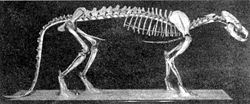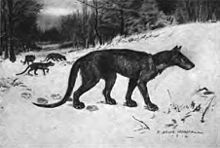- Daphoenus
-
Daphoenus
Temporal range: 42–16.3 Ma Early Oligocene-Early Miocene
Daphoenus skeleton. Scientific classification Kingdom: Animalia Phylum: Chordata Class: Mammalia Order: Carnivora Family: †Amphicyonidae Genus: †Daphoenus
Leidy, 1853Type species †Daphoenus vetus Species - †D. hartshorianus
- †D. lambei
- †D. ruber
- †D. socialis
- †D. transversus
- †Daphoenus vetus
Synonyms Pericyon
Daphoenus is an extinct member of the family Amphicyonidae ("bear dogs") belonging to the class Mammalia, an extinct order of terrestrial carnivores belonging to the suborder Caniformia, which inhabited North America from the Early Eocene subepoch to the Early Miocene subepoch 42—16.3 Mya, existing for approximately 25.7 million years.[1]
Contents
Taxonomy
Daphoenus was named by Joseph Leidy (1853). Its species was Daphoenus vetus. It was assigned to Amphicyonidae by Leidy (1853) and Carroll (1988); and to Daphoeninae by Hunt (1998) and Hunt (2002).[2]
Morphology
A single specimen was measured by Legendre and Roth in 1988 for estimated body mass.[3]
- 7.84 kg (17 lb).
Daphoenus was called "bear dogs" because they had characteristics of both bears and dogs. These animals were about the size of the present day coyote. Daphoenus vetus was the largest species. The male skulls could reach up to 20 cm in length. Daphoenus had short legs, and could only make quick sprints. These animals were not able to run long distances. It is thought that these animals ambushed their prey, and did some scavenging. Fossil footprints suggested that these animals walked in a flat-footed way. This is similar to the way that present day bears walk. Daphoenus dug burrows for their offspring to stay in and hide from their prey. [4]
Species
Amphicyonids are discussed in Robert M. Hunt's article Global Climate and the Evolution of Large Mammalian Carnivores during the Later Cenozoic in North America. D. Vetus was the largest of the species. D. hartshornianus, D. lambei (syn. D. demilo), D. ruber, D. socialis, D. transversus, D. vetus (syn. Proamphicyon nebrascensis)
Fossil distribution
Daphoenus fossils found in late Oligocene rocks in the Great Plains are dated at ~28 Ma. Daphoenus survived to 27 Ma in the Pacific Northwest in the John Day beds of Oregon.[5] Other sites include: Alachua County, Florida (Whitneyan) estimated at 31.1—24.3 Ma., Tecuya Canyon, California (Arikareean age) 30.8—20.6 Ma., Haystack Member Formation, Wheeler County, Oregon (Hemingfordian) 20.6—16.3 Ma., Lac Pelletier, Alberta, Canada (Duchesnean) ~42 Ma.
References
- ^ Paleobiology Database: Daphoenus, age range and collections
- ^ R. M. Hunt. 2002. New amphicyonid carnivorans (Mammalia, Daphoeninae) from the early Miocene of southeastern Wyoming. American Museum Novitates 3385:1-41
- ^ S. Legendre and C. Roth. 1988. Correlation of carnassial tooth size and body weight in recent carnivores (Mammalia). Historical Biology
- ^ Robbins, Neal. "Daphoenus- A Mammal of the Oligocene" Infohub.com. 4thMar.2007.Web. 12 Nov. 2009
- ^ Hunt, Robert M., Jr. (2004). "Global Climate and the Evolution of Large Mammalian Carnivores during the Later Cenozoic in North America". Cenozoic Carnivores and Global Climate. http://digitallibrary.amnh.org/dspace/bitstream/2246/453/8/B285a11.pdf.
Categories:- Bear dogs
- Oligocene mammals
- Miocene extinctions
- Prehistoric mammals of North America
- White River Fauna
Wikimedia Foundation. 2010.


